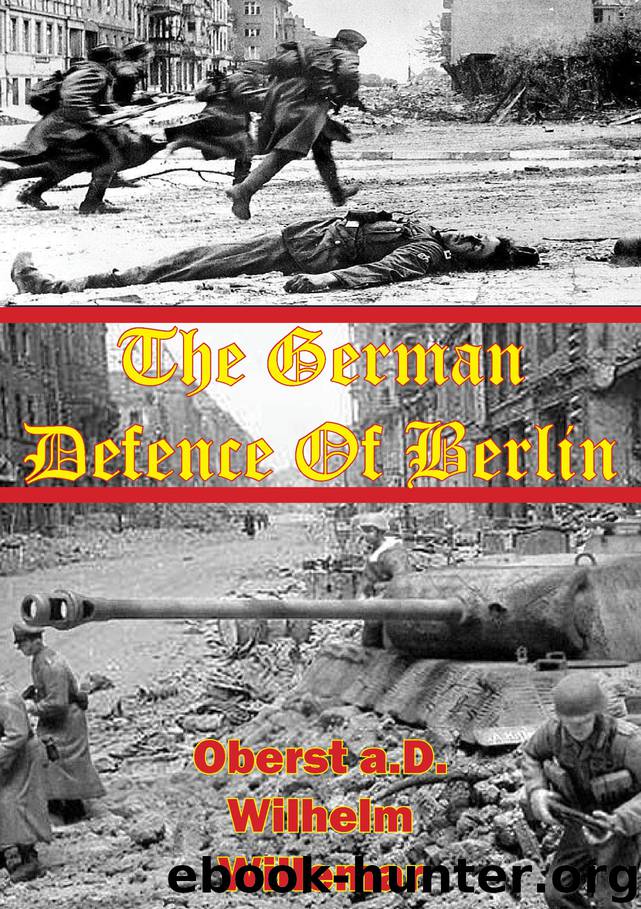The German Defense Of Berlin by Oberst a.D. Wilhem Willemar

Author:Oberst a.D. Wilhem Willemar
Language: eng
Format: epub
Publisher: Pickle Partners Publishing
Published: 2015-10-13T16:00:00+00:00
III. PLANS FOR DEMOLITION
1. Bridges. Preparations had been made to blow up all bridges and numerous overpasses in Berlin. Bitter quarrels subsequently arose between those who, like the Commander of the Defense Area, advocated military necessity, and those who wished to prevent the demolitions in the interest of the population. Reich Minister Speer, especially, did his utmost to moderate the extent of the destruction. The question was vitally significant not only because of the need for traffic routes, but above all because the water and sewerage mains lay under the bridges. Speer succeeded in obtaining from Hitler an order whereby a number of particularly important bridges were to be saved.
The degree to which the demolitions were carried out during the battle varied. Some of the bridges were only damaged, so that they could still be crossed by infantry and, after repairs, by tanks and other vehicles.
According to an investigation made by Colonel Roos, of the 248 bridges in Berlin 120 were destroyed and 9 damaged. (See Sketch 4, page 35.)
Only a few of the overpasses were blown up, apparently for lack of explosives.
2. Subway and City Transit Line Tunnels. The network of subway and city transit line tunnels could be used for covered movements by both friendly and enemy troops. In case of necessity they could be blocked at various points by setting off explosive charges that had already been planted.
In the course of the battle the city transit line tunnel under the Landwehr Canal was blown up, after which it filled with water. It could not be determined at whose orders this measure was carried out. With the blowing up of the Ebert Bridge (east of the Weidendamm Bridge) the city transit line tunnel there was also destroyed, although this was apparently unintentional. Because of these and other explosions, water flowed into large parts of the subway and city transit line tunnels in the heart of the city. (See Sketch 5, page 36.)
It could not be proven that any appreciable loss of life resulted from the flooding of these tunnels, but it can be seriously doubted that it was justified by military necessity.{13}
The tunnel leading from the Zoo railroad station (Bahnhof Zoo) to Ruhleben was heavily used by troops and civilians trying to break out toward the west.
3. Destruction of Business and Industrial Installations. On 19 March Hitler had issued instructions for demolitions which came to be known as the "scorched earth" order:
Download
This site does not store any files on its server. We only index and link to content provided by other sites. Please contact the content providers to delete copyright contents if any and email us, we'll remove relevant links or contents immediately.
| Africa | Americas |
| Arctic & Antarctica | Asia |
| Australia & Oceania | Europe |
| Middle East | Russia |
| United States | World |
| Ancient Civilizations | Military |
| Historical Study & Educational Resources |
U.S. Army Special Forces Handbook by Department of the Army(814)
Cyberspies by Gordon Corera(735)
Inside Delta Force by Eric L. Haney(679)
Tip of the Spear by Ryan Hendrickson(640)
No Easy Day: The Firsthand Account of the Mission That Killed Osama Bin Laden by Mark Owen; Kevin Maurer(592)
Black Ops: The Rise of Special Forces in the CIA, the SAS, and Mossad by Tony Geraghty(563)
Secret War by Nigel West(516)
The U.S. Intelligence Community by Jeffrey T Richelson(515)
SEAL Team Six by Howard E. Wasdin(510)
The Craft of Intelligence by Allen W. Dulles(489)
03 Shadow Warriors by Tom Clancy(426)
Anthony Blunt by Miranda Carter(418)
Eyes on Target by Scott McEwen(413)
SEAL Team Six by Howard E. Wasdin;Stephen Templin(404)
No Easy Day: The Firsthand Account of the Mission That Killed Osama Bin Laden by Mark Owen & Kevin Maurer(391)
Ultimate Guide to U.S. Special Forces Skills, Tactics, and Techniques by McCullough Jay(389)
No Hero: The Evolution of a Navy SEAL by Mark Owen & Kevin Maurer(382)
Bounty Hunter 43 by Jason Delgado & Chris Martin(379)
Psychology of Intelligence Analysis by Richard Heuer(353)
